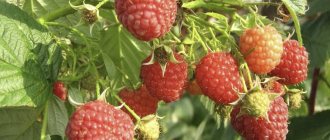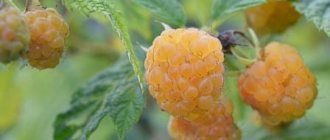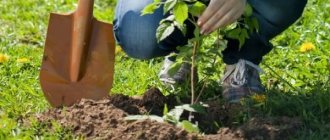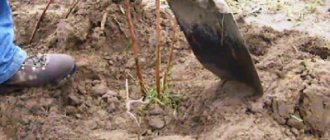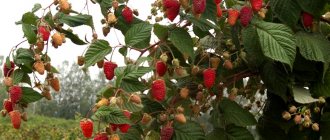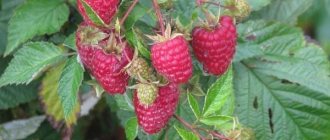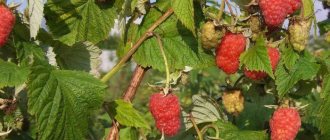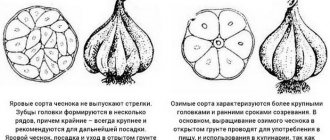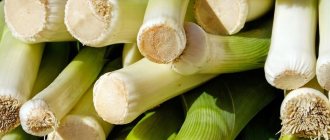Author: Natalya Category: Fruit and berry plants Published: May 29, 2016Republished: February 27, 2019Last edits: November 2, 2020
- Caring for raspberries in spring
- Spring pruning
- Reproduction by root suckers
- Diseases and their treatment
- Early remontant raspberries
Remontant raspberries are a group of crop varieties that are distinguished by their ability to bear fruit on both annual and biennial shoots. Remontant varieties have been known in gardening for about 200 years. From such raspberries you can harvest one harvest a year, or two, but the quality of the berries from the second harvest will be less high. Breeding work to develop remontant raspberries adapted to the climate of the middle zone began in the 70s of the last century, and since then many reliable varieties have appeared that have already become popular. Among them, a special place is occupied by the varieties of so-called standard raspberries, which are distinguished by their particularly strong stems that do not bend under the weight of the berries.
Planting and caring for remontant raspberries
- Planting: early spring or late September (early October).
- Lighting: bright sunlight.
- Soil: light, well fertilized, nutritious, loamy, with a pH of 5.8-6.7. It is advisable that the area be after black steam, and groundwater should lie on it no higher than 1 m from the surface
- Watering: abundant and regular, on average once a week, but more often in drought: the soil in the raspberry garden should be slightly moist all the time. When watering, the soil is soaked to a depth of 30-40 cm. Watering is especially important before flowering and during the period of growth and ripening of fruits. In October, abundant pre-winter watering is carried out. It is best to use the drip method for moisturizing.
- Feeding: when planted in fertilized soil, raspberries are not fed for 2 years, then annual feeding is required, preferably with organic matter: a solution of fermented mullein (1:10) or chicken manure (1:20). But if compost or humus is used as mulch, then organic matter may not be added. It is enough to add superphosphate only at planting, but raspberries need potassium (without chlorine) constantly.
- Pruning: for sanitary purposes - in the spring, during the period of swelling of the buds. The root shoots are also removed. And after fruiting is completed, all raspberry stems are cut off: in the spring it will produce new, healthy fruit-bearing shoots.
- Reproduction: by root shoots of four to five year old bushes (if the variety produces them) and green cuttings.
- Pests: raspberry bugs, aphids, spider and raspberry mites and caterpillars.
- Diseases: didimella (purple spot), anthracnose, septoria, verticillium (wilt), root canker (root goiter), curl, bushy dwarf, mosaic and infectious chlorosis.
Read more about growing remontant raspberries below.
Loosen the soil under the bushes
If you did not mulch your raspberry garden in the spring, do not neglect this procedure. After all, regular loosening improves oxygen access to plant roots, promotes the development of beneficial microflora in the soil and better moisture retention.
In total, 4-6 loosenings are needed per season. The first - in early spring before the buds bloom on the shoots, and the subsequent ones - as needed, when you see that a crust has formed on the surface of the soil or weeds have appeared. Carry out the last loosening of the soil in late autumn after significant cold snaps. This technique will help destroy some of the pests overwintering in the soil.
To avoid damaging the roots, loosen the soil under the remontant raspberry bushes to a depth of no more than 8 cm. In row-spacing, loosening can be deeper, but not more than 15 cm.
Botanical description
Raspberry is a perennial shrub. The main roots of raspberries are located at a depth of 15-30 cm, and adventitious ones can spread 2-3 m to the sides of the bush. Remontant raspberries are not much different from common raspberries, although some of their varieties almost do not form root shoots, while others generally have a low reproduction rate. In the spring of each year, raspberries of remontant varieties grow new shoots on which berries are formed. By the beginning of winter, the upper part of the shoot that bears fruit during the growing season dries out; on the remaining part, fruit branches form next year, as happens with conventional varieties, and on the other hand, the extended fruiting period allows you to obtain berries from the bushes throughout the entire season.
Remontant raspberries have other advantages compared to ordinary raspberries: they are more resistant to diseases and pests, therefore they have almost no wormy berries; it is much easier to care for; Almost all remontant varieties are large-fruited. In the modern garden, remontant raspberry bushes have become as commonplace as black currants, gooseberries, red currants, strawberries and other commonly grown berry crops.
We offer you material we have carefully selected on how to grow remontant raspberries from seeds, plant and care for remontant raspberries in open ground, how to determine which raspberries are remontant, how to prune remontant raspberries, how to care for remontant raspberries after harvesting, what diseases and pests of remontant raspberries are really dangerous. In addition, we will give a description of the varieties of remontant raspberries, dividing them into groups according to ripening time and adaptability to a particular region.
- Hawthorn: growing in the garden, properties, types
Top dressing
Remontant raspberries require a lot of nutrition. It needs to be fed a little more than usual. Once you start growing, you will see a huge green mass growing in one summer. At the beginning of the season, a lot of nitrogen is required.
The best option would be diluted urea and fermented chicken manure or any manure. From July we add ash and sprinkle it under the bushes before watering. Mown, plucked grass, rotting, provides excellent fertilizer. If you don’t like the smell of manure, buy a natural complex fertilizer and dilute it according to the instructions.
Here is a remontant raspberry, growing and caring for which is not at all difficult. The harvest, I'm sure, will please you. With this I say goodbye to you and wish you a good harvest. See you on the pages of Marivlad's blog.
Planting remontant raspberries
When to plant
Raspberries love light, but well-fertilized and moist soil. Groundwater should lie in the area with raspberries at a depth of no higher than 1 m. Remontant raspberries are even more demanding of lighting, soil fertility, moisture supply and heat. The area should be protected from the wind and very well lit, since in the shade the fruiting period is delayed and the harvest may not be as abundant as you expect.
The optimal soil for remontant varieties of raspberries is nutritious loam with a pH value of 5.8-6.7. Acidic soils will have to be limed by adding dolomite, marl or ground limestone. It is advisable that the area before planting raspberries be under fallow or under green manure crops such as mustard, rye, lupine, which need to be plowed into the ground a month and a half before planting.
Do not plant remontant raspberries in the place where peppers, potatoes, tomatoes or raspberries grew before them, since these crops can cause soil fatigue - depletion of soil in microelements and minerals.
Remontant raspberries are planted both in early spring and autumn, but the best time for planting in open ground is considered to be the end of September or the beginning of October.
Planting in spring
If you decide to plant remontant raspberries in the spring, you will have to prepare the area for it in the fall: clear the weeds and dig up the soil to the depth of a spade bayonet while simultaneously adding 2-3 buckets of high-moor peat or humus and a glass of superphosphate and potassium sulfate per m², or 200-400 g of complex mineral fertilizers.
Planting and caring for raspberries in the garden
In the spring, dig holes measuring 40x40x40 at a distance of 70 cm from each other, leaving row spacing of at least 1.5 m wide. The seedling planted in the ground should have a well-developed root system, the diameter of the shoot at the base should be at least 5 mm, and its length should be about 20 cm.
To make sure that the seedling is suitable for growing, cut off one bud from it before purchasing and pry off the bark on the shoot: the bark on the side adjacent to the wood should be green, and the bud should not be dry. If the seedling's root system has dried out somewhat, keep it for a day or two to swell before planting in water with a root formation stimulator.
Remontant raspberry seedlings are lowered into a hole and covered with fertile soil so that the root collar is strictly level with the surface of the site. On sandy soils, it is permissible to immerse the neck into the ground by 4 cm. After planting, the seedling is watered, and when the water is absorbed, the area of land around the bush is mulched.
Autumn planting
Autumn, as we have already written, is the best time to plant remontant raspberries. The area for raspberries is prepared in the spring - it is dug up and fertilizers are added to the soil. Otherwise, the principle and procedure for planting are the same as in spring.
The best dates for planting remontant raspberries in the regions
In the central part of Russia, various remontant varieties of raspberries begin to bear fruit in the last days of June - early July, and in Siberia and the Urals, most often you can enjoy the first berries only from July 25-30 or in the first ten days of August - it all depends on the weather of this summer. That is, the timing of the beginning of raspberry fruiting in the southern regions differs by about 4 weeks from the ripening of the crop in the north. In this way, the timing of planting remontant varieties also varies. But most often in Siberia, Transbaikalia and the Urals, gardeners use spring planting, since winter comes early in the northern regions. To the south of the European part of our country, the climate is milder; raspberries can be planted and replanted twice a year, as in the Krasnodar Territory, Kuban, Crimea and Ukraine - each gardener chooses the planting time independently.
Planting dates for remontant raspberries in Belarus
Since this variety of raspberries is not afraid of light frosts, planting begins in late March (the best varieties are Apricot, Indian Summer 2, Brilliant). In the temperate Belarusian climate, you can plant berry bushes for a whole month - until the end of April. It is important to plant raspberries in prepared soil with a sufficient amount of organic matter and minerals; limestone is used to neutralize acidic soils. Regular watering will allow the seedlings to quickly take root and begin to grow.
Planting dates for remontant raspberries in Ukraine
In Ukraine, the temperate continental warm climate allows you to plant raspberries both in autumn and spring . Winter comes at the end of December, especially in the southern regions of the country, so berry bushes planted in spring and autumn can take root with equal success, provided that the plants are regularly irrigated, shaded and the soil is loosened. In the arid steppe of Ukraine, raspberries are planted in the spring; the most suitable varieties are Indian Summer, Yantarnaya, and Zolotye Domes. On the Black Sea coast of Ukraine, with a climate close to subtropics, the planting season for berry bushes begins in early spring and continues until the first serious cold snap.
Planting dates for remontant raspberries in the Moscow region
As soon as the snow has melted and the soil has warmed up, remaining loose and moist, they begin to prepare planting holes for berry bushes. If the threat of frost has passed, replanting begins - from late March to mid-April. The main thing for the Moscow region is to choose a non-wetland area, preferably an upland with good drainage and fertile soil, and a suitable variety (for example, Augustin, Bryanskoe Miracle, Golden Autumn). In Moscow and the Moscow region, autumn planting of remontant raspberries is rarely used - the plants take root worse. Since the raspberry root system is located on the surface and most often freezes before it takes root completely.
Planting dates for remontant raspberries in Siberia and the Urals
In conditions of unstable cold weather with freezing frosts and strong winds, a well-warmed area protected by buildings or plantings is chosen for planting remontant raspberries. Plants are planted in the garden after the onset of warming, when the threat of a return to negative temperatures has passed - from mid-May to the second ten days of June. Shrubs are often replanted in the fall - in the first ten days of September, if necessary. Thick snow cover is the main insulation for raspberries in Siberia. Properly selected zoned varieties, cultivated for a long time in the harsh Siberian climate, guarantee abundant and long-term fruiting of remontants (Bryansk Miracle, Ruby Necklace, Orange Miracle, Atlant, Penguin, Nizhegorodets).
Growing remontant raspberries
Caring for raspberries in spring
Caring for remontant raspberries begins in early spring, in early March - on still frozen soil they are fed with full mineral fertilizer.
In April, sanitary pruning of raspberries is carried out - shoots that have frozen or dried out over the winter are shortened to the first healthy bud. If last year you suspected that fungi had settled in the raspberry bushes, treat the bushes in mid-April with a one percent solution of iron sulfate or Nitrafen. If you do not find any signs of fungus, the first preventive treatment of remontant raspberries with fungicides, for example, Topaz or Ridomil, is carried out in the first week of May.
Remontant raspberries in the spring require foliar feeding with a complete mineral fertilizer with the addition of a growth stimulator. At the end of May, remontant raspberries are treated against pests with some biological insecticide - Actofite or Lepidocide, for example.
Don’t forget to water the area every week, loosen the soil and pull out the weeds - raspberries do not tolerate weeds and soil compaction. The first loosening of the site is carried out in early spring, before the buds begin to bloom: the row spacing is loosened to a depth of 10-15 cm, and the soil around the bushes - to 5-8 cm. If for some reason you have not mulched the soil in the raspberry garden, then during the season you you will have to carry out 4 to 6 loosenings.
- Strawberries: diseases and pests and their control
How to care in summer
Caring for and growing remontant raspberries in the summer requires regular watering and loosening of the soil. Tall raspberry varieties must be attached to supports or tied up. To do this, strong high fastenings are driven in along the row every three meters, between which wire or rope is pulled in 2-3 levels - at a height of 50 cm, 1 m and 1.5 m from the surface of the site.
Remontant raspberries already begin to ripen in the summer, so it is not advisable to use pesticides to protect them from pests and diseases.
To prevent the berries from burning during periods of too active sun, remontant raspberries should be protected from the harmful effects of direct sunlight with nets or thin spunbond, which is thrown over the bushes.
Autumn care
Remontant raspberries sometimes bear fruit in the fall until it gets cold. Spent shoots are cut off before winter, only part of the stems 20 cm high are left on newly planted bushes, and complete pruning is carried out the following year. After pruning, the raspberry tree is cleared of plant debris and old mulch, which should preferably be burned, since they may contain pests or pathogens.
After this, moisture-recharging pre-winter watering of remontant raspberries is carried out, after which - the last loosening of the soil with the turnover of the layer, and then the soil surface is mulched for the winter with a layer of half-rotted manure or humus 10 cm thick.
Watering
Growing remontant raspberries requires regular and sufficient watering. On average, you need to moisten the soil in a raspberry garden once a week, but in dry times, you may have to do this much more often. The soil in the raspberry garden should be slightly moist all the time.
Water the raspberries generously so that the soil is wet to a depth of 30-40 cm. The most important thing is to ensure soil moisture before flowering, as well as during the period of growth and ripening of the fruit. Before wintering, raspberries are watered abundantly.
However, care should be taken to avoid stagnation of water, since it can cause even more damage than insufficient watering - in wet soil, air stops flowing to the roots, the soil becomes cold, and this can cause a slowdown in development, especially in spring.
The most effective way to water remontant raspberries is by drip. It saves water and the soil is moistened evenly. But you can simply moisten the soil with a hose or use ditch irrigation. To do this, rollers of earth 10-15 cm high are raked around the rows, and water is poured into a shallow ditch formed under the roller. Do not use cold water for irrigation, let it warm up first. If you mulch the area in the spring, the frequency of watering is noticeably reduced.
Top dressing
If you dug up the soil in the area before planting with the specified amount of fertilizer, your remontant raspberries in open ground will not need fertilizing for two years. From the third year it is necessary to apply fertilizers annually. Raspberries respond very well to organic matter, which contains almost all the elements necessary for feeding this crop and improves the soil structure.
The best organic soil additives are a solution of fermented mullein in a ratio of 1:10 and a solution of chicken manure in a ratio of 1:20. Organic matter is added 2-3 times from the beginning of the growing season at the rate of 3-5 liters per m² of plot. But if you have a good habit of regularly mulching your raspberry garden with humus or compost, then you don’t have to add any special organic matter.
In addition to organic fertilizers, remontant raspberries also need mineral fertilizing, and in some cases it is enough to add superphosphate only at planting, but without potassium, raspberry leaves become small, their edges turn brown, and the tissue between the veins dies. You can only apply potassium fertilizers to the soil that do not contain chlorine - potassium magnesia or potassium sulfate, for example.
The best complete mineral fertilizer for remontant raspberries is Nitroammofoska or its analogues, which is enough to apply in early spring at 50-100 g per m², or distribute 50-80 g of superphosphate, 20-40 g of potassium sulfate and 20-40 g of urea per m² .
Transplanting remontant raspberries
It is advisable to grow remontant raspberries in one place for 10-15 years, after which, as soon as the yields begin to fall or the berries begin to shrink, the bush is dug up, divided into parts, the sections are treated with crushed charcoal, after which parts of the bush are planted in a new place. Sometimes raspberries are replanted because the wrong place was initially chosen for it.
- How to plant mirabilis for seedlings and in the ground
The transplant is carried out at the same time and in the same order as the initial planting.
Care
To obtain high yields, the crop needs to create comfortable conditions. Caring for remontant raspberries includes watering, fertilizing, pruning, and pest control.
Top dressing
Remontant varieties are usually high-yielding and in the process of growth and fruiting deplete the soil. Therefore, the main task of the gardener is to apply organic and mineral fertilizers in the spring. Plants need nitrogen to grow green. For 10 liters of water you need to take 20 g of urea or 30 g of ammonium nitrate. This feeding is one of the most important - the growth of the bush depends on it.
Note: It is best to use ready-made complex fertilizers in which the composition is balanced. They contain all the necessary elements, growth stimulants and vitamins.
Raspberries can get potassium and phosphorus from wood ash. Under each bush you need to sprinkle 1 glass of this fertilizer.
The timing of fertilizing is presented in the table:
| Humus (first application) | Nitrogen | Mineral complex | Potassium-phosphorus | Organic (before wintering) | |
| Middle lane | March, April | June July | Second half of August | Beginning of September | Late October-early November |
| Northern regions and Siberia | April | July | Late July-early August | Mid August | Late September-early October |
| South of Russia | February March | May June | Late June-early July | October | November |
Watering and loosening
Watering is required as needed depending on weather conditions; it is carried out in the morning or evening. Raspberries do not tolerate drought well, but at the same time, stagnation of water is unacceptable. It is best to practice drip irrigation, which maintains the required level of soil moisture and does not allow changes in humidity.
Instead of a drip irrigation system, you can use furrow irrigation: dig a furrow about 12-15 cm deep near the raspberry bushes and feed water into it using a hose.
Loosening should be done constantly to ensure oxygen access to the roots. This is done with caution, due to the fact that the roots are close to the surface.
To water raspberries, it is better to use a drip irrigation system.
Trimming
Raspberry pruning can be preventive or sanitary.
During preventive pruning, all excess shoots are removed so that per 1 sq. there were no more than 12 of them.
Sanitary is needed to remove dried and frozen fragments. It is easiest to find such areas when the buds are swelling.
To obtain one harvest, before wintering, all above-ground parts of the plant are cut off and burned.
To harvest two harvests, old and weak shoots are removed in the fall. The top of the young ones, which already had fruits, is cut off. Then the raspberries are covered for the winter. In the spring, all dry and frozen branches are removed and the bush is treated against diseases and pests.
Pest treatment
To prevent pest damage, soil and bushes are disinfected. After removing the winter shelter, all plant debris is removed from the area. The treatment is carried out in the spring in the morning or evening with personal protective equipment (respirator, gloves and goggles). Biological and chemical preparations are used:
- To destroy aphids, mites, whites, weevils, codling moths, cabbage moth larvae, sawflies, cutworms, they are sprayed with Fitoverm and Agravertin.
- A Nitrofen solution is used against the raspberry beetle: dilute 200 g of the substance in 10 liters of water.
- Chlorophos, Fufanon, Actellik are used against crimson mosquitoes (gall midges), the larvae of which form growths on the stems that burst in places of swelling.
- The drug Kemifos is effective against the strawberry weevil, which eats flower buds.
Fighting raspberry diseases
The most common diseases of remontant varieties include the following:
- Rust on sheet plates. The causative agent is a fungus. The affected parts of the plant must be quickly cut off and destroyed. The disease cannot be cured. It is important to detect it as early as possible, so it is necessary to regularly inspect the plants.
- Drying of roots and shoots. Requires watering and fertilizing.
- Curling of leaves. This occurs when there is a lack of potassium, so you need to apply potassium-phosphorus fertilizers.
- Powdery mildew. A fungal infection that occurs when there is high humidity. The plant requires timely treatment with antifungal agents.
This is what raspberry leaves look like when they are affected by powdery mildew.
Preparing for winter
Preparation for wintering begins with treating the soil against pests and applying phosphorus-potassium fertilizers. During dry autumn, watering is necessary. The latter is carried out about a week before the predicted frosts, so that the roots do not dry out during wintering. Mulching of the soil is required - a layer of 5 cm is enough.
Pruning is done depending on how many crops are required. Only old shoots and fruit-bearing tops are removed or the entire bush is cut off at the root. Annual shoots left for the winter need to be tied up.
If covering is required, use spruce branches, snow or special covering material that allows air to pass through.
Tying raspberries
Some raspberry varieties can grow up to 2 meters. To prevent the shoots from breaking from wind and rain, they are tied to a trellis. In this form, the plants are better ventilated and illuminated. In addition, well-fruiting raspberries cannot do without a garter, otherwise the bush will not withstand the load.
For remontant raspberries, it is most convenient to use a two-plane trellis. It consists of two parallel wires stretched at a distance of 0.5 m. Biennial shoots that produce the first harvest are placed on one plane, and annual shoots that will produce a harvest in the fall are placed on the other. Supports for raspberries must be stable and reach a height of 1.8-2.5 m.
The bushes are tied up with fabric tapes or secured with clamps or clamps.
Tied raspberries are easier to care for and more convenient to harvest
Pruning remontant raspberries
Spring pruning
After wintering, frostbite, dry patches or cracks may appear on those raspberry bushes whose shoots have not been pruned at the roots. In this case, sanitary pruning of remontant raspberries is carried out, removing the affected shoots to the first healthy bud. Do not trim the tops of healthy stems - this will delay fruiting and may negatively affect the amount of harvest. Remontant raspberries are pruned when the buds on them begin to swell - at this time it is easy to determine which buds are healthy and which are damaged.
If you are growing a variety of remontant raspberries that produces a lot of root shoots, remove them mercilessly, leaving no more than 10-15 stems per m² of land, half of which are annual replacement shoots, and the second part are biennial fruiting shoots.
Autumn pruning
We advise you to cut all the stems of remontant raspberries at the root after fruiting. Next year, in the spring, new shoots will grow, which during the growing season will have time to grow, ripen, bloom and produce a good harvest. Since pathogens and pests have nowhere to wait out the winter, new shoots will grow healthy. In addition, the development cycle of the main raspberry pests coincides with the ripening period of ordinary raspberries, and by the time remontant raspberries produce their harvest, fears that the berries will be attacked by harmful insects will become irrelevant.
Raspberry varietal characteristics
Remontant raspberry varieties differ from others in that they are able to bear fruit not only on two-year-old shoots, but also on annual shoots. Fruiting on two-year-old branches is no different from usual. The second flowering (on annual shoots) occurs at the end of July, and the berries ripen unevenly in August-September.
Did you know? The greatest contribution to the production of productive domestic varieties of remontant raspberries was made by Professor I.V. Kazakov. He developed more than 20 varieties of this berry, and 8 of them are included in the State Register of Breeding Achievements.
Most varieties can be grown as an annual crop by cutting off the entire above-ground part before the cold weather. Many of them were obtained as a result of repeated interspecific crossing and have poor root growth, which makes their propagation by conventional methods difficult.
Propagation of remontant raspberries
Reproduction by root suckers
Despite the fact that most of the remontant varieties almost do not form root shoots, there are also those in which offspring appear. The largest number of root shoots is formed in four to five year old bushes - from 2-3 to 10-15 per m² of site. When the shoots reach a height of 5-10 cm, they dig them up in cloudy weather, transplant them to a school bed, water them, mulch the soil around them and shade them from the sun.
Further care consists of regular watering, and when the shoots take root, which usually happens after two weeks, the protection from sunlight can be removed. By autumn you will have excellent seedlings that can be planted in a permanent place.
Propagation by root cuttings
During the autumn loosening of the site, dig up a raspberry root with a diameter of at least 2 cm, divide it into segments 8-12 cm long, plant them in a continuous row in a furrow 6-8 cm deep, bury, water and mulch the surface. Throughout the next season, water and loosen the soil on the site, remove weeds, feed young plants, treat them against pests and diseases, and at the end of the season, transplant the seedlings to a permanent place.
Propagation by green cuttings
Cuttings of remontant raspberries are harvested at the end of spring from annual shoots no more than 3-4 cm high, some of which are underground. The cutting should have a rosette of leaves. The cuttings are cut at a depth of 5-6 cm and removed along with a lump of earth. The sections are treated with crushed coal, and the cuttings are immediately planted on a bed in a greenhouse according to a 5x10 cm pattern at the same depth in which they grew and watered.
The soil for rooting cuttings is a mixture of river sand and peat. Water the cuttings, protect them from overheating, and when they take root, ventilate the greenhouse to harden the cuttings. When they can spend a day in the fresh air, they are transplanted into open ground to a permanent place.
We told you about propagating remontant raspberries by dividing the bush in the section on replanting.
Propagation by cuttings
The easiest way to propagate remontant raspberries is by cuttings. The second-year shoots that bear fruit are cut off in the fall and divided into cuttings with 1-2 buds, 12-20 cm long. They are planted in the ground, compacted and covered with a jar (film). For the winter they are covered with agrofibre. In spring, the cuttings take root and produce leaves. If they are planted densely, the seedlings are transplanted.
Practice has shown that it is much easier to grow remontant raspberries, getting a harvest only from annual shoots. But with any growing method, the plant requires fertile soil, a sunny area and watering during the dry period.
Pests and diseases of remontant raspberries
Diseases and their treatment
Remontant varieties of raspberries have increased resistance compared to ordinary ones, but sometimes they can also suffer from insects or diseases. Among the diseases that most often affect remontant raspberries are fungal diseases such as didimella, or purple spot, anthracnose, septoria, verticillium, or wilt. Treatment of raspberries with fungicides is effective against fungi - Bordeaux mixture, Topaz, Oskihom, Fundazol, Fitosporin, Switch, Amistar, Skor and others.
In addition to fungal diseases, remontant raspberries can be damaged by bacterial diseases - root canker or root goiter. Bacterial diseases can only be combated by preventive measures - carefully inspect seedlings before purchasing, strengthen the plant’s immunity, strictly follow agrotechnical measures and care recommendations developed for this crop, and regularly carry out preventive treatments.
Pests and diseases of raspberries - control and prevention
The most serious problem for any plant is represented by viral diseases - curl, bushy dwarfism, mosaic and infectious chlorosis. They are scary because there is no cure for them yet, and if you find signs of the disease, the only way out is to destroy the diseased plant.
Sometimes raspberries can be disfigured by a mycoplasma disease - growth, or witch's broom, which also cannot be cured. How to deal with incurable diseases? Only by preventive measures. Firstly, conduct regular inspections of raspberry plantings and, if diseased specimens are found, immediately and mercilessly remove and burn them. New ones cannot be planted in the place where the diseased plant grew for several years.
Maintain a high level of agricultural technology, feed raspberries to increase their resistance to pathogenic microorganisms, wage a merciless fight against weeds and pests that carry diseases, plant only healthy seedlings and maintain a distance between remontant raspberries and common raspberries, which are more easily and quickly affected by diseases and pests, therefore serves as a source of infection for remontant raspberries.
Pests and their control
Of the large list of raspberry pests, remontant varieties are most often affected by raspberry bugs, aphids, spider and raspberry mites and caterpillars. After raspberries bloom, it is not advisable to treat them with chemicals.
In pest control, it is recommended to use herbal preparations, for example, infusions of onion peels or garlic that are effective against ticks. 100 g of onion peels or crushed garlic are infused in 10 liters of water for 2-3 days, then the infusion is filtered and 50 g of laundry soap dissolved in warm water is added to it. Instead of soap, you can use concentrated dishwashing liquid.
An infusion made according to the following recipe is successfully used against leaf-eating and sucking insects: a liter jar of wood ash is diluted in 5 liters of water, and 50 g of grated green laundry soap is dissolved separately in a liter of water. A small bottle with a capacity of 30-50 ml is filled halfway with cold water, a teaspoon or dessert spoon of kerosene is poured into it, the bottle is sealed and shaken vigorously for several minutes so that the gasoline does not cover the surface of the water with a film, but mixes evenly with it. Then the first two solutions are filtered, mixed, kerosene water is added to the resulting mixture, water is added to make 10 liters, and immediately used to process remontant raspberries.
If you notice pests on raspberries before flowering, you can resort to treating them with biological insecticides such as Bitoxibacillin, Actofit or Lipidocide.
If you want to get more detailed information about pests and diseases of remontant raspberries, find the article “Diseases and Pests of Raspberries” on the website, which describes in detail all the problems of this crop and how to get rid of them.
Protect your plantings from diseases and pests
Unlike summer raspberries, remontant raspberries are much less susceptible to diseases and pest attacks. However, this does not mean that you need to forget about preventive measures, especially if in the fall you do not cut out all the shoots at the root.
To prevent fungal diseases in the spring, spray the bushes with 1% Bordeaux mixture. During flowering and formation of ovaries, regularly inspect the plants and remove all shoots affected by diseases and pests. In the fall, after harvesting, spray again with Bordeaux mixture. This treatment will help destroy pathogens, as well as the larvae of some pests that have settled in for the winter.
Varieties of remontant raspberries
Early remontant raspberries
Early ripening varieties of remontant raspberries include those that ripen at the end of July and in the first ten days of August. For example:
- Hercules is a large-fruited, consistently productive and disease- and pest-resistant early variety with straight-growing shoots that do not require support or tying. The fruiting zone occupies half the length of the shoots. The variety is distinguished by thin, hard and prickly thorns, dense, very large berries weighing up to 10 g, truncated conical shape and thick ruby color with a sweet and sour refreshing taste. The bush of this variety bears fruit from the beginning of August until the first frost;
- Diamond is a profusely fruiting variety that ripens in the first ten days of August. The height of the bush is up to 1.5 m, soft thorns are located at the base of the stem, the fruiting zone is half the length of the stems. The berries are conical, large (some weighing up to 7 g), rich ruby color with a bright gloss. The taste of the berries is dessert, sweet and sour;
- Bryansk Yubileinyaya is a medium-growing, compact, productive variety that ripens in the third decade of July. The berries are large and medium in size, weighing up to 6 g, elongated in shape, bright red in color and sweet and sour taste;
- Apricot is one of the most exotic varieties of remontant raspberries, which, moreover, is almost not affected by diseases and pests. The thorns are located at the bottom of the shoot, which makes harvesting easier. The berries of this variety, weighing only 3-4 g, ripen in early August, have the shape of a blunt cone, have an amber-golden color and an apricot flavor. Apricot raspberries bear fruit until frost;
- Eurasia is a high-yielding, disease- and pest-resistant, early-ripening and large-fruited variety with standard-type shoots and rare thorns located along the entire length of the stem. The raspberries of this variety are conical, dense, dark crimson in color and can weigh more than 6 g. The taste of the fruit is sweet and sour.
Mid-season varieties
Medium-ripening varieties of remontant raspberries include those that are ready for harvest in the second half of August:
- Orange miracle is a large-fruited, disease-resistant raspberry variety whose elongated, blunt-conical berries can weigh 12 g and 4 cm in length. The bright orange fruit has a dessert, sweet and sour taste. Raspberries of this variety bear fruit until frost;
- Ruby Necklace is a productive variety with dense, large berries of bright ruby color, weighing more than 8 g. The taste of the fruit is sweet and sour, refreshing. The thorns located at the bottom of the shoots do not interfere with harvesting;
- Mulatto is an abundantly fruiting variety, resistant to diseases and pests, with round, shiny dark cherry medium and large berries weighing up to 5 g. The taste of the fruit is sweet and sour;
- Golden Autumn is a large-fruited, productive variety with short, soft thorns located in the lower part of the shoots, and dense golden-yellow berries of an elongated conical shape weighing up to 7 g. The taste of the fruit is dessert, with a subtle raspberry aroma;
- Firebird is a productive large-fruited variety, the shoots of which have soft and thin thorns located in the lower and middle parts of the shoots. The conical shape of the berries can reach a weight of 6 g. The taste of the fruit is dessert, sweet and sour, the flesh is tender and juicy.
Late varieties
There are not as many late-ripening varieties of remontant raspberries, ripening at the end of August or even in September, as there are early and mid-ripening ones. Among the most famous are the following:
- Heritage is a winter-hardy and disease-resistant variety of American selection, obtained by crossing the varieties Durham, Katberg and Milton. Red, round, aromatic berries begin to ripen in late August or early September;
- Morning dew is a large-fruited variety of Polish selection ripening at the end of summer with yellow fruits weighing up to 8 g with an excellent sweet and sour taste;
- Otm Treasure is a raspberry ripening in late August or early September, resistant to diseases and pests, with dense, juicy light red berries of good taste, elongated conical shape and weighing up to 5 g. The variety was obtained by interspecific crossing of the Otm Cascade and Glen Moy varieties;
- Zyugana (Shugana) is a drought-resistant mid-late Swiss variety with medium-sized tasty berries, which, with good care of the bush, can reach a weight of 10 g;
- Erica is one of the best productive varieties of Western European selection. The berries have excellent taste, dark red, dense, large and shiny.
Varieties for the Moscow region
Among the varieties of remontant raspberries, many are adapted to the conditions of the middle zone, and you just have to choose the most productive and winter-hardy from them. The following raspberries grow well in the Moscow region:
- Bryanskoe Miracle is a promising high-yielding variety with strong stems that do not require support, and red elongated conical berries, sometimes weighing 20 g. The fruits begin to ripen in the second half of July, and fruiting lasts until the end of September;
- Polka is a hybrid of Polish selection between the varieties Otm Bliss and the experimental sample of the line P89141, characterized by increased shoot formation. Fruiting of this variety begins in August and lasts until frost. Polka berries are very large, dense, shiny, elongated in shape and have a deep purple color and can weigh up to 12 g;
- Atlant is a disease and pest resistant, large-fruited and highly productive variety with short and sparse thorns located at the bottom of the shoots. The berries are elongated-conical in shape, dense, large, weighing up to 9 g. The taste of the fruit is sweet and sour, the pulp is juicy and tender;
- Penguin is an early-ripening, disease- and pest-resistant raspberry variety with a standard-type bush, medium-sized dark thorns concentrated in the lower part of the shoots and medium-sized dense, round-conical berries of a dark crimson color;
- Indian Summer is a high-yielding, early-ripening variety that is not affected by diseases and raspberry mites, with ruby-colored juicy berries of excellent taste.
Varieties of remontant raspberries for Siberia. When choosing varieties of remontant raspberries for growing in Siberia, keep in mind that the most important secret of success is to awaken the raspberries in the spring as early as possible. The best remontant varieties for cultivation in conditions of short summers and harsh winters are:
- Monomakh's cap is a productive, almost thornless bush in the form of a small tree with beautiful large, blunt-conical berries of a rich red color, sometimes reaching a weight of 20 g;
- Unattainable is an early-ripening, high-yielding variety with a bush height of up to 160 cm, which begins bearing fruit at the end of July and ends in October. The bright red, tender, sour-sweet berries of this variety reach a weight of 7 g. The variety lives up to its name in all respects;
- Augustine is a productive variety with short thorns and broadly blunt-conical berries weighing up to 4.5 g of dark crimson color with dense, tender, sweet pulp;
- Reliable is one of the most stable varieties in terms of yield, resistant to unfavorable climatic conditions, which is why it got its name. Blunt-conical red glossy berries weighing up to 5 g have a pronounced aroma and excellent taste.
The best varieties
There are many varieties of remontant raspberries, and naming the best of them is not an easy task, because each gardener has his own requirements and evaluation criteria. But based on the totality of their indisputable advantages, the best varieties of remontant raspberries include Hercules, Yellow Giant, Indian Summer, Atlant, Penguin and Apricot.
New varieties of remontant raspberries
Remontant raspberries are becoming increasingly popular among amateur gardeners, and this is not surprising, since its advantages over common raspberries are undeniable. That is why experiments on developing new remontant varieties are becoming more and more intense. This process was especially active at the beginning of the 21st century, when the varieties Hercules, Diamond, Monomakh's Cap, Inaccessible and Penguin appeared, which we have already described. Among the more recently bred varieties, Golden Domes, Autumn Beauty and August Miracle are of interest.
What does remontant raspberry look like?
The varieties of this raspberry resemble a Christmas tree: many side shoots with branches extend from the trunk, on which many flowers bloom and fruits quickly set.
Good bushes by the end of summer have a height of up to 1.5-1.8 m and 10-12 stems with a large number of lateral branches and many flower tassels and formed berries.
Due to a large harvest, the branches will bend and may break in the wind, so it is recommended to tie them to supports.
Remontant raspberries during fruiting are a real decoration of the garden plot. It can be planted singly, in rows or in compositions.
Correct choice of planting material
It’s easy to get lost among the variety of remontant raspberry varieties. For the first planting, it is best to choose mid-season and late varieties - they will have time to take root and produce a good harvest in the first season.
You should not buy planting material from unverified sellers; it is better to contact nurseries or more experienced gardeners. There are many cases when the purchased raspberries turned out to be sick, weak and did not correspond to the characteristics of their variety.
The seedlings should have a well-developed root system, and the above-ground part should not exceed 25 cm in length.
Planting dates in spring and autumn
You can plant remontant raspberries in spring or autumn. The planting period in autumn is longer, from late September to early November. Plants planted in the fall take root much better. The only danger that threatens the seedlings is freezing, but this problem is easily solved. The area is covered with snow or some kind of protective material.
Spring planting eliminates the threat of freezing of young shoots. You can start planting remontant raspberries in the spring from the end of February in the south of the country until April in the northern regions. However, spring planting also brings certain difficulties: it only takes two to three weeks to plant the entire raspberry tree.
It takes time for seedlings to begin to grow intensively, so active fruiting is shifted to a later period.
Reproduction
Remontant raspberries are propagated vegetatively in the same way as varietal raspberries, but they produce much less young shoots and grow weaker. There is also the possibility of propagation by seeds, but the probability of preserving varietal characteristics is about 60% and the long period of cultivation makes this method ineffective compared to others.
Root suckers
The fastest and most gentle method of propagating raspberries, used throughout the growing season. Select sprouts that have reached no more than 25 cm in height. They are dug up with part of the rhizome and immediately transplanted to a permanent place. To protect from direct sunlight, wooden shields are installed on the southern, eastern and western sides of the beds, shading the seedlings for 2 weeks.
Remontant varieties produce few such offspring, so another method of obtaining them is practiced. In autumn or spring, the central branches of the bush designated for propagation are cut down along with part of the rhizome. The part remaining in the ground forms many offspring, which, as they grow, are used for planting.
Root cuttings
Root cuttings are harvested in the fall. The dug up rhizome is cut into pieces 10–15 cm long. They can be planted immediately, covered with spruce branches for the winter to protect them from freezing. If desired, root cuttings are prepared for spring planting.
The rhizome is not cut, but sprinkled with wet sawdust and sent for storage in the basement or cellar. Over the winter, many growth buds will awaken and the amount of planting material will increase significantly.
Green cuttings
Green cuttings up to 5 cm high, growing at the base of the rhizome, are suitable for propagation. They have the strength and energy sufficient to quickly grow their own root system. They are harvested in the spring, cutting them with a knife at the root to a depth of 3–5 cm, so as not to damage the mother plant.
The sprouts are planted in a greenhouse for growing and shaded. A month later, when the required number of roots is formed, the seedlings are transplanted to a permanent place.
Watering and fertilizing
In order for the bushes to develop well and actively bear fruit, the plant must be regularly watered and fed. Raspberries love moisture very much, but cannot tolerate overflows or stagnation of water. Therefore, special attention must be paid to the required level of humidity.
For most regions, natural watering is not enough, so additional measures must be taken. The ideal way to water a raspberry tree is drip irrigation. Such watering maintains a given level of humidity and prevents sudden changes in soil moisture.
If it is not possible to install a drip system, another method comes to the rescue - furrow irrigation. A small groove 10–15 cm deep is dug next to the raspberry tree, and water is supplied into it using a hose or watering can.
To reduce the number of waterings and prevent the soil from drying out, the soil in the raspberry garden must be mulched. You can use hay, sawdust and other organic matter as mulch.
Mulched soil not only retains moisture, but also perfectly suppresses the growth of weeds, and subsequently also fertilizes the soil.
Preparing for winter
In order for the bushes to develop well and actively bear fruit after wintering, they need to be properly prepared for it. All work must be completed before the onset of cold weather.
Preparing for winter begins with tilling the soil. You need to add phosphorus-potassium fertilizers to it and treat it against pests (if necessary). If autumn is dry, you need to water the raspberries additionally. A week before the expected frost, make the last watering so that the roots do not dry out over the winter, and mulch the soil. There is no need to lay out a large layer of mulch; 5 cm is enough.
Raspberry trees are pruned depending on plans for the future harvest. You can cut off all the branches at the root, or you can remove only the old shoots and tops that had berries. If annual shoots remain overwinter, they need to be tied up.
Remontant raspberries need to be covered for the winter; for these purposes, you can use different materials: regular snow (if there is enough of it), spruce spruce branches or special non-woven materials that allow air to pass through.
If preparations for winter have been carried out correctly, next season there will be more berries, and they will become larger and sweeter.
Compliance with all recommendations for the care, treatment and protection of plants will extend the life of the raspberry plant. With proper care, remontant varieties can bear fruit for many years.
Landing
Both autumn and spring planting are possible, it all depends on the region.
- When planting in the fall, there should be at least a month left before frost; the method is suitable for the southern regions.
- In spring, planting is carried out after the snow cover has completely melted, the soil has warmed up and dried out.
Setting the stage
The soil is prepared six months before the start of the main work. How to prepare a place for growing:
- Remove all weeds from the soil.
- Distribute peat in an amount of 3 kg per 1 m2.
- Dig up the bed with a shovel, mixing garden soil with fertilizer.
- When digging, you can improve the soil composition with superphosphate or a mineral complex. 200 g of organic matter per bucket will be enough, but if possible, check the composition of the soil.
We plant
Raspberry seedlings are planted according to general rules. The roots are kept in a disinfectant solution.
Young bushes are planted in a common trench with an indentation of 0.5-1 m. An interval of 1.5 m is maintained between the rows.
The holes are sprinkled with a nutrient mixture based on peat, garden soil, wood ash and manure. The root collar is buried 3 cm, this will protect it from drying out.
Technology and planting patterns
Depending on the gardener’s preferences and the characteristics of the site, one of the following planting methods is selected.
Bush
The bush planting method is the easiest and most common. Holes measuring 50x70 cm are placed in a square or in a checkerboard pattern at a distance of 80–100 cm from each other. 1 bush is planted in each hole.
Trench
The trench method is more labor-intensive, but it pays off with the possibility of subsequent processing of row spacing using a mechanized method and the possibility of using rolled materials for mulching. This method is used in the industrial cultivation of raspberries and involves the installation of trellises for tying. Trenches are formed 50 cm wide and 40 cm deep to an arbitrary length, placing them at a distance of 1.5–2 m from each other. Plants in a row are spaced every 40 cm.
Landing on ridges
Forming beds of remontant raspberries on ridges is a rather labor-intensive process. This technology is used in swampy areas or on heavy clay soils. Its essence is that a trench about 80 cm deep is dug at the site of the bed and one third is filled with wood debris: branches, bark and sawdust.
Then the excavated soil is mixed with humus and mineral fertilizers and the ditch is filled to the general level. After watering the trench, the seedlings are placed on the surface in increments of 50 cm and sprinkled with the remaining soil, forming a ridge. Sheets of slate or boards are installed along its edges to a height of about 30 cm to protect it from destruction.
Warm beds
The method of constructing warm beds is even more complex than the previous one and is used in harsh climates or if you want to get an extra-early harvest. Heating of the soil is achieved through the decomposition of organic residues embedded in the soil under the raspberry bushes. To construct such beds, trenches 1 m deep are dug, which are fenced with slate to a height of 60–80 cm from the soil level.
The entire volume is filled with alternating layers 10–15 cm thick of sawdust, a mixture of soil with humus and organic waste mixed with fallen leaves and mineral fertilizers. The top is covered with a mixture of peat, humus and sunflower or buckwheat husks. After abundant watering, organic matter gradually decomposes and releases heat. After 2–3 weeks, holes are made and raspberries are planted in the usual way.
Tape
The method is used in the industrial cultivation of raspberries on sandy soils and also involves the formation of trenches with a pitch of 2–2.5 m, a width of 1 m and a depth of 0.5 m.
To fill ditches, layers of manure or compost are used, a mixture of soil with humus and fertilized with ash, superphosphate and potassium sulfate. A large volume of enriched soil serves for several years to nourish remontant raspberries, planted in the resulting beds in rows of 50x70 cm.
Planting in a container
The method of planting remontant raspberries, which has been gaining popularity recently, developed from the idea of decoratively growing remontant strawberries and other berry crops in flowerpots. Bushes can be grown both in open ground and in any containers that are unnecessary on the farm - old buckets, leaky barrels or even bags.
Holes are made in the bottom of the drainage or it is removed completely, and the container is dropped in the selected location. After filling with the nutrient mixture, they plant raspberry bushes. If necessary, such a container can be moved around the site, making plant care easier and saving water and fertilizer consumption.
Did you know? For decorative purposes, raspberry varieties have been bred with double flowers 5 cm in diameter with white, purple and pink colors and corrugated leaves.

